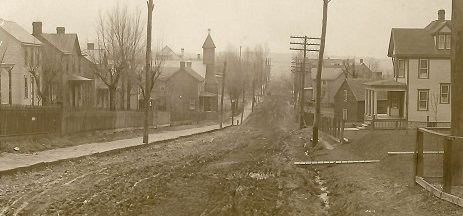
|
The Power of Memory |
|
Speech
at Smithfield's "Celebrate the Centuries" Event |
The entire weekend has celebrated the ways a
town has a meaningful impact on the lives of its citizens.
We have seen how over 201 years, its lasting institutions – churches,
schools, businesses, the war memorial, and especially people – have become
symbols of Smithfield’s identity and culture.
Despite all our differences as human beings, these are the elements that
unite and bind a community together.
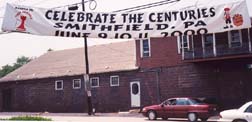
Banner in Smithfield, 2000
Today, I want to look at Smithfield differently. I’d like you to think about how a single family with many branches, of about the same age as Smithfield, has had an impact on these towns. The family of course is the Minerd family, spelled three ways – “E-R-D,” “E-R” and “O-R.”
What I’ll say is not meant to mean that our clan is any bigger or better or more interesting than any other family. In fact, on a widespread basis, we are very ordinary. Rather, as we study the family and understand its role in society, we realize the Minerds are symbolic of many Smithfield families that put down roots allowed time to work its magic, and together built this nation.
My talk today will focus on Smithfield,
Fairchance and communities -- White House, Woodbridge, Haydentown, Bowood and
Old Frame.

Volunteer fire department
Let me give you a brief background so you will get a better sense of our family’s staggering size. The Minerds have been in Fayette County for about 210 years. In 1791, Revolutionary War veteran Jacob Minerd and his wife Maria settled in the mountains above Mill Run. They had 12 children – of whom we know the identities of seven. These seven children in turn had 67 children, 310 grandchildren and 790 great-grand-children -- virtually all born before the year 1900. Thus, a century ago, some 1,200 cousins had been born.
During the 20th century, the family exploded in size even more. I started counting in 1990, and found 2,500 cousins and spouses, past and present. As word spread, and relatives contributed their own research, the numbers swelled. By 1995 we knew of 8,000. Today we know of an astonishing 13,000. There’s no end in sight. Thousands more are waiting to be discovered, some right here in Smithfield and Fairchance.
In the process, I’ve become fascinated with how a single family can have a massive impact on society, over multiple generations, through its collective work.
Minerds have lived in all parts of Fayette
County -- Smithfield, Fairchance, Uniontown, Connellsville, Normalville, Mill
Run, Brownsville, Masontown, Farmington. They’ve
lived in the counties of Somerset, Washington, Greene, Westmoreland, Allegheny,
Beaver. They’ve migrated to Preston County and Monongalia County,
West Virginia. Many pushed further
west into Ohio, Indiana, Iowa, Kansas, Missouri.
Nebraska. New England. The South. The
West Coast. Japan. England. Switzerland.
Germany. Italy.
All over the world.

U.S. Post Office
In Smithfield and Fairchance alone, there have been at least 90 Minerd family households. In a few minutes I’ll read you their names so you’ll understand the variety. In fact, of all Minerds everywhere, only 1 out of 100 has some form of the family name. In other words, 99 out of every 100 have some other name, reflecting that in each generation, women marry and change their names. As a result, most cousins don’t even know they belong to our family.
One of the first cousins to live in Smithfield was William Minerd. William and his wife Sara Whoolery settled here about 100 years ago. He was a coal miner. They had eight children, many of whom put down roots and whose descendants live here today. William served in the 85th Pennsylvania Infantry in the Civil War. One day his index finger was shot off while he was walking picket duty at Bermuda Hundred, Virginia. William Minerd was a great family man. He stood strong for his adult children when they went through divorces, were widowed at young ages, and lost their own children in tragic accidents.
One of William Minerd’s daughters, Mary Ann, married Haley Patrick Cross – or Patrick Haley Cross, depending on the day of the week. Haley -- or Patrick -- also served in the Civil War. He enlisted under one name, but when he did not get paid, he deserted and enlisted in another regiment under his transposed name. After the war he worked as a coal miner and drew a military pension. In fact he drew two pensions because the government thought he was two people. Later in life the government caught up with him and he was reduced to only one pension.
Another of William Minerd’s daughters,
Jennie, had a painful life, but typical for the age.
In 1897 she married Albert Harrington, a laborer at the Oliver coke
works. A year later, Albert
enlisted in the Army during the Philippine Insurrection.
He and his mates sailed to Hawaii before going on to Manila.
One night, in Honolulu, Albert was run over by a horse and buggy.
He was taken back to the ship and died.
Albert was buried in Honolulu. Strangely,
the cemetery today has no record of his burial.
Nor is there any record in the Army’s papers that the body was shipped
back here. The Pennsylvania Room at
the Uniontown Public Library has checked its extensive cemetery records, but –
he’s not here either. Where is
Albert Herrington?

Happy celebration banner
Albert’s widow Jennie later married John Worrick, a coal miner. In 1910 John was working at the Donald #1 Mine when he fell and broke his neck, and died. The accident was kept out of the newspapers. But in a dusty old volume in the Heinz History Center in Pittsburgh, we’ve found his story in a report of the Department of Mines. It said he was “instantly killed. He was found dead under his trip of loaded cars. It is supposed that he fell off the front.” Having been widowed twice, Jennie moved to Warren, Ohio. I have enjoyed corresponding with Jennie’s great-granddaughter who now lives in Portland, Oregon.
William Minerd’s son
Thomas lived in 10
different places in Uniontown and Smithfield, working as a mining boss.
Tom and his wife Kate had 10 children, but only four survived to
adulthood. Among their descendants
were Charles Irvin Minerd, whose name is on Smithfield’s War Memorial; his
wife Freda Minerd, a longtime teacher here; and Bob Kennison Jr. whose wife Rita
helped organize this wonderful celebration.
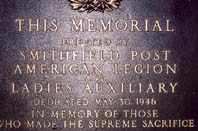
War memorial, Smithfield
Another interesting set of cousins were Ray Addis and Robert and Harold Rankin. In 1936, they lived on the mountain near the Summit Hotel above Uniontown. If you’ve read Buzz Storey’s book Stories of Uniontown, you know about their heroic effort. That year, 1936, a TWA airliner – the Sun Racer -- crashed near the Summit. Ray Addis and the Rankins were the first people to reach the crash site. They clawed their way up the steep hill, and helped survivors escape the burning wreckage. Their pictures appeared in the newspapers, along with their story in their own words. Later in life, the Rankins moved to Smithfield.
Another interesting cousin was Dr.
Roy Sheppard Minerd.
He was a teacher and principal of the Fairchance Grade and High Schools
from 1910 to 1913, before going to medical school and becoming one of our
family’s first physicians. Later,
he and his wife Nell lived in Smethport, McKean County, where he was a country
doctor. While Roy only had lived in
Fairchance for a few years, the town made a positive impression. We know this because in 1949, they took a vacation, drove
through the town and he wrote about it in his travel diary, of which we have a
copy in our archives:
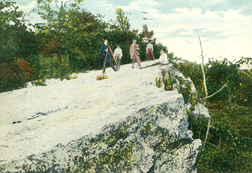
Tourists on the White Rocks
A few miles up the Cheat River from Morgantown … is the spot where around 1910 I used to take a group of my high school boys, from Fairchance, for summer camping… From Point Marion it is but a few miles to Fairchance, a little town about the size of Smethport, where I spent three years...
Dr. Roy’s son Bob made history in 1945. As an ensign on the destroyer Frederick Davis, his ship was one of the last to be sunk by U-Boats during World War II. Bob Minerd was washed overboard, but survived. As senior surviving officer, he had to write more than 100 letters to grieving parents of his dead shipmates. Bob is mentioned in Samuel Eliot Morrison’s definitive Naval History of the War.
The last story I’ll tell is about James Calvin Minerd Sr.. He and his wife Suvina Yauger lived on a farm at Bowood in the early part of the century, after he retired as a stable boss for the Frick Coke Company. James and Suvina had 15 children, and the number of grandchildren is off the scale. Most of their sons and sons in law worked in the coal and coke industry. A son was a doughboy in World War I. A grandson, Albert McCabe, moved to California, where he became a navigation engineer and designed the Apollo rocket engine. He received a letter of commendation signed by all the Apollo astronauts.
I’ve told you some of the more colorful
stories of the family. But it’s
not the headlines that build and strengthen the fabric of a family or a
community. Rather, lasting impact
comes from the daily grind, month after month and year after year, usually
without any fanfare.

Prominent banner in town
Here are some other names of cousins who’ve lived here:
~ Smithfield ~
Alisvard ~ Atkinson ~ Brumley ~ Conn ~ Crayton ~ Cross ~ Guthrie ~ Hartman ~ Kennison ~ Kingan ~ Leech ~ Lowller ~ Marshall ~ McClain ~ Miller ~ Moats ~ Monahan ~ Morrison ~ Myers ~ Rankin ~ Reinhart ~ Rockwell ~ Rowan ~ Shaffer ~ Shay ~ Squires ~ Stafford ~ Taylor ~ Victor ~ Walls ~ Walters ~ Warman ~ Zinn.
~ Fairchance ~
Addis ~ Baker ~ Campbell ~ Cottom ~ Firestone ~ Fisher ~ Garletts ~ Grimm ~ Hennigan ~ Huey ~ Inks ~ McKnight ~ Miller ~ Pringle ~ Spaw ~ White ~ Wilson.
|
|
|
Fairchance's unpaved Church Street, looking west from Main Street |
We hold a
national reunion every July for the family at large, or anyone interested in
coming. Each reunion has a
different theme to keep it fresh and interesting, and we publish our results.
Our first theme was in 1994 when we highlighted 22 Civil War soldiers in
the family. Other reunions have
honored many hundreds of educators, coal, coke and steel workers, and wartime
military veterans.
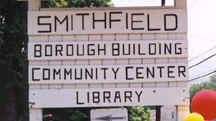
Center of town cultural activity
The reunion thus has become more than just a social event. It has evolved into a national clearinghouse for networking, information and research.
This year our theme is “21st Century Families” -- a futuristic look at what’s ahead for families. As we begin a new century, we can only wonder what our world will be like 10, 25 or 50 years from now. What jobs will we have? Will we be free of disease? And perhaps most important: What will our families be like?
Award-winning writer Jeff Minerd will offer a glimpse of the challenges, choices and opportunities ahead for families. Jeff lives near Washington, DC and covers science and technology for The Futurist, a national magazine. He’ll share predictions and observations, covering technology, healthcare and culture. He’ll also offer practical advice on how to create family balance.
We also will announce the official formation of our Minerd Archives, built over the past 15 years. It now contains more than 24,000 documents and photographs. We not only collect Minerd material, but share it as well. I like to paraphrase a line from the movie Hello Dolly – “Money is like manure … It doesn’t do any good unless you spread it around.” And so it is with family information.
We’ve also launched our brand-new reunion and research website – www.minerd.com. Minerd.com contains more than 250 biographies of cousins born in the 1800s, including the people you’ve heard about today, plus many, many more. It also features a "Photo of the Month," reunion information, our German heritage, family quirks and culture, and publications
Before I close today, let me ask you a
question. How many of you believe
memory is important? How many feel
there is value in remembering the past and giving it honor?
How many of you know how easy it is to forget?
How many of you remember Princess Diana?
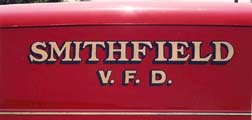
Pride of the town
No, she’s not a Minerd cousin. But you all know her story. Her marriage to Prince Charles, her two sons, her much-publicized divorce, her tragic death in Paris. How many of you watched her funeral on TV? Last September the New York Times, carried a surprising story on the second anniversary of her death. The headline read "Two Years On, Diana Is the Forgotten Princess.” Here are the first few paragraphs:
Now, two years later Britons are struck by how quickly the woman whose funeral drew the largest TV audience in history has come to be overlooked in her own land. H ow swiftly buttoned-up royal reserve has returned and how few of the societal changes that were so confidently forecast have actually taken place. Plans for a monument in Kensington Park have been shelved The exhibit about her life and death at her stately family home, Althorp House, is no longer a sellout.
Pretty surprising, isn’t it? I guess it’s human nature, that the living generation keeps going, and lets the past slip away.
But it raises important questions, one I’ve often thought about while walking through the cemeteries here in town, and others throughout the County. How will You and I be remembered? Do we want to be known simply by our names on a gravestone and a yellowed newspaper obituaries? Do we want to be forgotten entirely? Or do we want something more?
What will become of all your experiences that have built Smithfield and Fairchance into such special places? What will it take to make sure your life is kept fresh in the minds of the descendants who will follow you 100 years from now?
You might say, “My life isn’t important. What I’ve done is not much different from anyone else.” That’s a common response I’ve heard. People don’t realize they are a key part of Americana. They don’t understand why anyone would find their lives interesting.
Here’s my radical suggestion: Tell your story yourself. Set aside a few hours today or tomorrow, and begin jotting down some notes. Write a few paragraphs about your favorite memories of Smithfield, what you remember about school, what you did for fun, where you lived, or interesting people you knew. Write what you experienced in the Depression, or in World War II or Korea or Vietnam. How will future generations have any idea of what the Depression was like, or World War II, unless you tell them? How -- will -- they -- know?
You are part of this community. The Minerds are part of this community, too. Your experiences of Smithfield and Fairchance need to be remembered long into the future.
Copyright © 2000, 2006, 2022 Mark A. Miner
